Lolo Barberry Berberis × lologensis
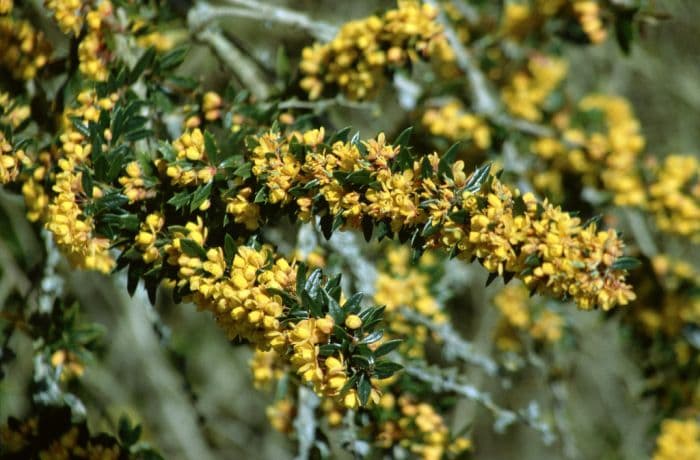
ABOUT
The plant in question, commonly known as the Lolo Barberry, is a visually striking and complex plant due to its hybrid nature. It bears a mix of characteristics that arise from its parentage. The Lolo Barberry typically features small, glossy, and evergreen leaves that exhibit a rich green color, contributing to its dense and lush appearance. The leaves are arranged in a way that gives the plant a textured and layered look, visually pleasing and suitable for hedges or ornamental purposes. During the blooming season, the Lolo Barberry produces flowers that tend to be small and clustered. These flowers are usually yellow, adding a splash of bright color against the green foliage. The flowering season brings not only visual interest but can also attract pollinators to the garden. Following the flowering period, the plant may also produce small, oval-shaped berries. These berries can add further interest to the plant's appearance as they often show up in shades of red or dark blue, though the presence and color of the berries can widely vary. Overall, the Lolo Barberry is recognized for its vibrant foliage and seasonal color changes, which may occur due to its flowers and berries. With its dense leaf structure, it can serve as a lovely and functional addition to landscapes.
About this plant
 Names
NamesFamily
Berberidaceae.
Synonyms
Lolog Barberry, Michay.
Common names
Berberis × lologensis.
 Toxicity
ToxicityTo humans
The plant commonly known as Barberry can be toxic to humans if ingested. The primary toxic components of Berberis species, including Berberis × lologensis, are isoquinoline alkaloids such as berberine. Symptoms of poisoning from ingesting barberry may include stomach upset, nausea, vomiting, diarrhea, dizziness, fainting, and difficulty breathing. In severe cases, low blood pressure and respiratory failure could occur. It is important to seek medical attention if poisoning is suspected.
To pets
The Barberry plant is also toxic to pets. Similar to humans, pets can suffer from the toxic effects of isoquinoline alkaloids like berberine if they ingest the plant. Symptoms in pets may include vomiting, diarrhea, lethargy, and loss of appetite. Depending on the amount ingested, more severe symptoms can include tremors, seizures, hypotension, and respiratory failure. Pet owners should contact a veterinarian immediately if they suspect their pet has ingested any part of a barberry plant.
 Characteristics
CharacteristicsLife cycle
Perennials
Foliage type
Evergreen
Color of leaves
Green
Flower color
Yellow
Height
6 feet (1.83 meters)
Spread
5 feet (1.52 meters)
Plant type
Shrub
Hardiness zones
7
Native area
Argentina, Chile
Benefits
 General Benefits
General Benefits- Landscape Aesthetics: Adds visual appeal with its attractive foliage and bright yellow flowers.
- Habitat for Wildlife: Provides shelter and food for birds and other wildlife.
- Erosion Control: Helps stabilize soil with its root system.
- Low Maintenance: Requires minimal care once established, making it a practical choice for gardeners.
- Drought Tolerance: Can survive in dry conditions, reducing the need for irrigation.
- Border Fencing: Can be used as a natural barrier or hedge due to its thorny nature.
 Medical Properties
Medical PropertiesThis plant is not used for medical purposes.
 Air-purifying Qualities
Air-purifying QualitiesThis plant is not specifically known for air purifying qualities.
 Other Uses
Other Uses- Berberis × lologensis, commonly known as Lolog barberry, can be used as a natural dye source, with its roots, bark, and berries potentially yielding shades of yellow, orange, or deep red on fabrics.
- The thorny branches of Lolog barberry may serve as a natural deterrent, making it an effective barrier plant to discourage trespassing animals or humans when planted as a hedge.
- The dense habit of Lolog barberry can provide shelter for small wildlife, offering a safe habitat within gardens and landscapes.
- The bright berries of Lolog barberry attract birds, which in turn can aid in seed dispersal and help maintain the ecosystem's balance.
- The plant's drought tolerance makes it suitable for xeriscaping, reducing the need for irrigation in drier climates.
- As an ornamental plant, Lolog barberry's attractive foliage and fall colors add aesthetic value to parks and gardens during different seasons.
- In bonsai culture, Lolog barberry can be manipulated into miniature forms, offering an artistic approach to gardening and plant cultivation.
- Lolog barberry can be used in erosion control projects where its roots help stabilize slopes and prevent soil degradation.
- During autumn, the foliage of Lolog barberry can be collected and used as a natural mulch, providing nutrients back to the soil as it decomposes.
- The plant's compatibility with a variety of soil types allows it to be used in land reclamation projects to restore disturbed sites.
Interesting Facts
 Feng Shui
Feng ShuiThe Barberry is not used in Feng Shui practice.
 Zodiac Sign Compitability
Zodiac Sign CompitabilityThe Barberry is not used in astrology practice.
 Plant Symbolism
Plant Symbolism- Resilience: Berberis, also known as barberry, is known for its hardy nature and ability to thrive in challenging conditions, symbolizing resilience and perseverance.
- Protection: With its sharp thorns, the barberry plant is often considered a symbol of protection, as it can form an impenetrable barrier against intruders.
- Sharpness: The thorns on a barberry also signify sharpness or acuity, reminding us to stay alert and protect ourselves from potential harm.
 Water
WaterThe Michay should be watered deeply, allowing the water to soak into the soil, reaching the root zone. It's important to water it once every week to ten days, depending on weather conditions, with reduced frequency during cooler or rainy periods. Generally, giving the plant about 1 to 2 gallons of water each time should keep it healthy. Overhead watering is discouraged because it can promote foliar diseases; instead, use a soaker hose or drip irrigation for best results. Ensure the plant has well-draining soil to prevent root rot from water stagnation.
 Light
LightThe Michay thrives best in full sun to partial shade. The ideal spot would be where it can receive at least six hours of direct sunlight but is protected from the intense midday sun. A location that gets morning sunlight and afternoon shade is often ideal for maintaining vibrant foliage and encouraging flowering.
 Temperature
TemperatureMichay plants prefer moderate temperatures and are hardy in a range typical to many temperate regions. They can tolerate a range of temperatures but perform best when the climate is between 50°F and 75°F. Although they can withstand cold down to about 0°F, they should be protected from frost to prevent damage to the foliage and stems.
 Pruning
PruningPrune the Michay to remove dead or damaged wood and to shape the plant, which encourages new growth and flower production. The best time to prune is in late winter or early spring before new growth starts. Pruning should occur annually, ensuring to use clean, sharp tools to make precise cuts without harming the plant.
 Cleaning
CleaningAs needed
 Soil
SoilBarberry 'Lologensis' thrives best in well-draining soil with a pH between 5.5 and 7.5. Mix garden soil with peat moss and perlite in equal parts to enhance drainage and create a slightly acidic to neutral environment ideal for this barberry variety.
 Repotting
RepottingThe Lologensis Barberry should be repotted every 2-3 years or when it has outgrown its current pot. Ensure the new pot has adequate drainage and is slightly larger than the previous one.
 Humidity & Misting
Humidity & MistingLologensis Barberry does well in average outdoor humidity levels; it is not particularly sensitive to humidity and adapts to typical garden conditions without the need for special humidity adjustments.
 Suitable locations
Suitable locationsIndoor
Place in bright indirect light and ensure proper drainage.
Outdoor
Full sun to partial shade, well-drained soil, hardy plant.
Hardiness zone
5-9 USDA
 Life cycle
Life cycleBerberis × lologensis, commonly known as the Lolol berberry, begins its life cycle with seed germination, which is typically followed by a period of root establishment and the development of foliage. As a perennial shrub, it enters a vegetative stage where it grows leaves, stems, and branches, adapting to its environment. The plant then progresses to the reproductive phase, producing clusters of yellow flowers that attract pollinators, a crucial step for cross-pollination. Following pollination, the flowers develop into small, berry-like fruits that contain seeds, which, once mature, are dispersed by birds or other mechanisms. The plant undergoes a period of dormancy during colder months, conserving energy and resources. Over time, the Lolol berberry can spread and form dense thickets, contributing to its survival and the continuation of its species through multiple generational cycles.
 Propogation
PropogationPropogation time
Spring to Summer
Propogation: The most popular method of propagating Berberis × lologensis, commonly known as the Lolog barberry, is by semi-hardwood cuttings. This process typically takes place during the late summer months. To propagate by cuttings, one should select healthy, semi-hardwood stems from the current year's growth. These stems should be cut into lengths of 4 to 6 inches (about 10 to 15 cm) and have a few leaves remaining at the top. The bottom cut should be made just below a node, and the cuttings should be dipped in rooting hormone powder to encourage root development. The treated cuttings are then inserted into a well-draining potting mix, ensuring that at least one node is buried where roots can form. It is important to maintain a humid environment for the cuttings by covering them with a plastic bag or placing them in a propagation case, and keeping them in indirect light until they root, which typically takes several weeks.

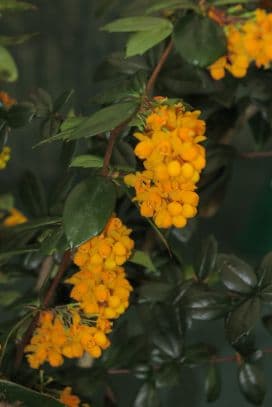
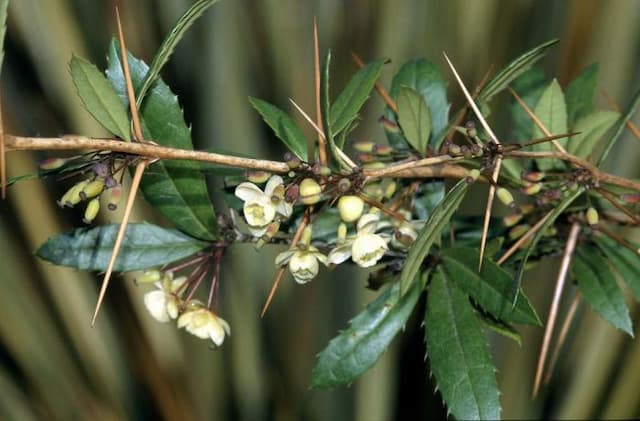
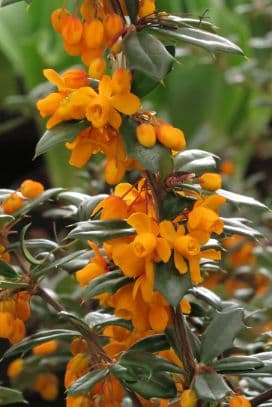
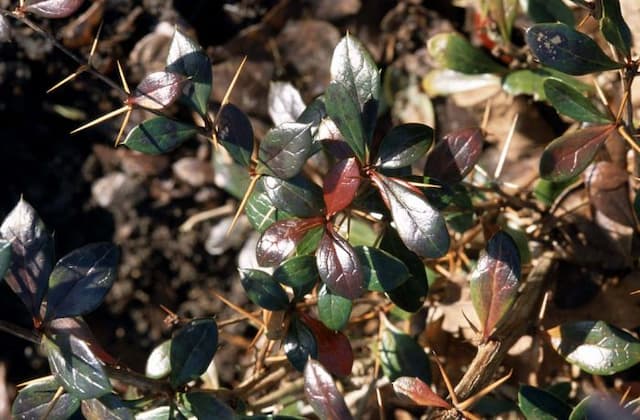


![Japanese barberry [Bonanza Gold]](/_next/image?url=https%3A%2F%2Fplants-admin.emdemapps.com%2Fimages%2Fplants%2F%2Fimages%2F604b5385e413f.png&w=640&q=75)

